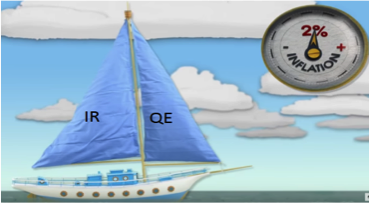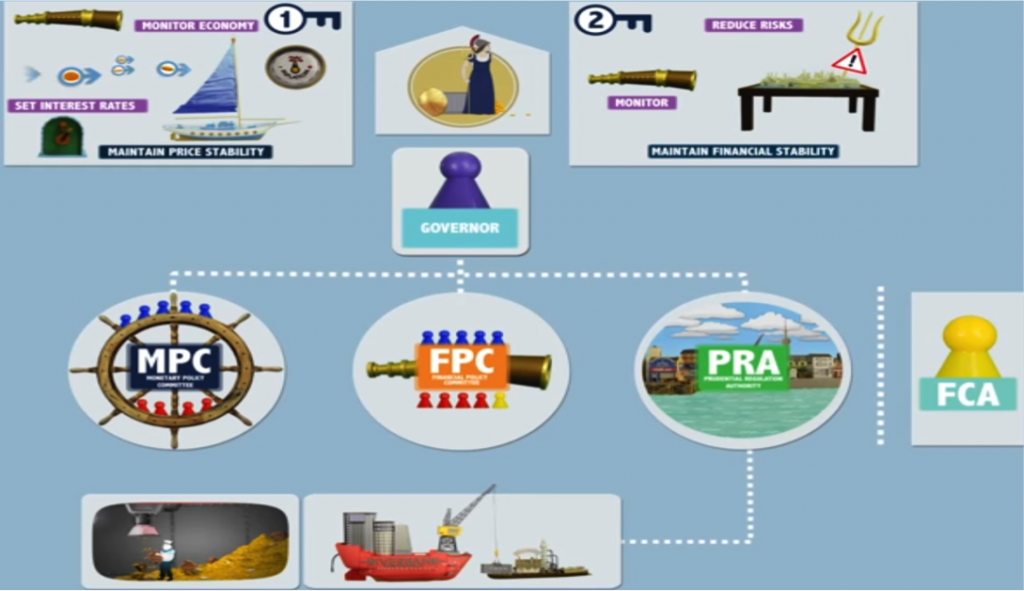The Role of the Central Bank
The Role of the Central Bank
Defining the term base rate and explaining the role of the MPC in setting the official interest (base) rate
-
The Bank of England was made independent of the government in 1997.
-
This meant that the government was no longer taking monetary policy decisions, even though the Treasury keeps in close touch with the bank. This removed political bias from MP prior to elections…
-
The Monetary Policy Committee (MPC) was set up to consider and decide on the level of the base rate on a monthly basis.
-
The base rate/bank rate is the interest rate at which the central bank lends to commercial high-street banks – thus influences their interest rate on overdrafts/credit-cards/loans/mortgages!
-
Its deliberations are minuted and then published approximately two weeks later so that the process is open to scrutiny.
-
The MPC comprises nine members, including 5 Bank of England officials and 4 independent experts appointed by the Chancellor.
-
Their target, set by the government, is a 2% rate of inflation.
-
This is symmetrical and a deviation beyond 1% in either direction requires a letter of explanation from the Governor of the Bank of England to the Chancellor of the Exchequer.
-
(Inflation below 2% can mean that prices are inflexible and this can make it harder for the economy to grow in a normal, healthy way – causing uncertainty)
How monetary policy is used to control inflation
-
The base rate is set so as to meet the 2% inflation target and create long-term stability in the macroeconomy.
-
If aggregate demand is growing faster than aggregate supply (i.e. AD>AS), the demand will bid up prices and inflation will accelerate – demand-push inflation.
-
Demand can be damped down by raising rates of interest, making borrowing more expensive. This will discourage investment and consumer borrowing.
-
The early signals that demand is growing too fast can usually be seen in the form of skills shortages across a range of industries.
-
If inflation is too low, there will probably be rising unemployment and under utilised capacity in many businesses; there is scope for faster economic growth. I.e. AS>AD – thus lower IR as an economic stimulus for AD.
-
In addition to controlling interest rates, central banks can buy assets from other banks and this pumps money into the economy. This is known in the UK as quantitative easing. Turning assets/bonds into more liquid cash!
-
These assets are mostly bonds sold to cover the public sector deficit but also bonds that are effectively loans to businesses. It is a useful way of stimulating the economy if low interest rates are having little effect.
How the regulation of the UK banking industry works
-
Banks occupy a key position in the economy. It is important that they survive; if they are making big losses, their lending has to be curtailed, which can be disastrous for borrowers.
-
The Financial Policy Committee (FPC) comprises 5 senior officials at the Bank of England, 4 external officials appointed by the Chancellor with major responsibilities for bank regulation/economic policy specialists and the chairperson of the FCA.
-
They meet quarterly to take a more long-term view of the state of the economy and the position of the banking system within it.
-
The FPC’s objectives are to ensure financial stability, to reduce risks, to ensure that the financial system remains resilient and to support government policy. It focuses on determining the underlying principles of effective banking.
Summary
Summarising the role of The Bank of England – banker to the banks, banker to the gov, regulates the financial system, manipulates the exchange rate and acts as a ‘lender of last resort’
-
Central banks have always been expected to act as ‘lenders of last resort’.
-
This means lending to banks when they are temporarily unable to meet customer demands to withdraw money.
-
There are two sides to this: smoothing out the day-to-day fluctuations in the money markets and lending to banks that are in serious difficulty.
-
Both help keep a sustainable economy and minimise any ‘shocks’ that a ‘bank failure’ would cause.
Further Reading:
Bank Of England’s Knowledge Bank website - http://edu.bankofengland.co.uk/knowledgebank

